
- Podcast Features
-
Monetization
-
Ads Marketplace
Join Ads Marketplace to earn through podcast sponsorships.
-
PodAds
Manage your ads with dynamic ad insertion capability.
-
Apple Podcasts Subscriptions Integration
Monetize with Apple Podcasts Subscriptions via Podbean.
-
Live Streaming
Earn rewards and recurring income from Fan Club membership.
-
Ads Marketplace
- Podbean App
-
Help and Support
-
Help Center
Get the answers and support you need.
-
Podbean Academy
Resources and guides to launch, grow, and monetize podcast.
-
Podbean Blog
Stay updated with the latest podcasting tips and trends.
-
What’s New
Check out our newest and recently released features!
-
Podcasting Smarter
Podcast interviews, best practices, and helpful tips.
-
Help Center
-
Popular Topics
-
How to Start a Podcast
The step-by-step guide to start your own podcast.
-
How to Start a Live Podcast
Create the best live podcast and engage your audience.
-
How to Monetize a Podcast
Tips on making the decision to monetize your podcast.
-
How to Promote Your Podcast
The best ways to get more eyes and ears on your podcast.
-
Podcast Advertising 101
Everything you need to know about podcast advertising.
-
Mobile Podcast Recording Guide
The ultimate guide to recording a podcast on your phone.
-
How to Use Group Recording
Steps to set up and use group recording in the Podbean app.
-
How to Start a Podcast
-
Podcasting
- Podcast Features
-
Monetization
-
Ads Marketplace
Join Ads Marketplace to earn through podcast sponsorships.
-
PodAds
Manage your ads with dynamic ad insertion capability.
-
Apple Podcasts Subscriptions Integration
Monetize with Apple Podcasts Subscriptions via Podbean.
-
Live Streaming
Earn rewards and recurring income from Fan Club membership.
-
Ads Marketplace
- Podbean App
- Advertisers
- Enterprise
- Pricing
-
Resources
-
Help and Support
-
Help Center
Get the answers and support you need.
-
Podbean Academy
Resources and guides to launch, grow, and monetize podcast.
-
Podbean Blog
Stay updated with the latest podcasting tips and trends.
-
What’s New
Check out our newest and recently released features!
-
Podcasting Smarter
Podcast interviews, best practices, and helpful tips.
-
Help Center
-
Popular Topics
-
How to Start a Podcast
The step-by-step guide to start your own podcast.
-
How to Start a Live Podcast
Create the best live podcast and engage your audience.
-
How to Monetize a Podcast
Tips on making the decision to monetize your podcast.
-
How to Promote Your Podcast
The best ways to get more eyes and ears on your podcast.
-
Podcast Advertising 101
Everything you need to know about podcast advertising.
-
Mobile Podcast Recording Guide
The ultimate guide to recording a podcast on your phone.
-
How to Use Group Recording
Steps to set up and use group recording in the Podbean app.
-
How to Start a Podcast
-
Help and Support
- Discover

Indian History with Dr. Veenus
History

Harappan Civilisation to Vedic Civilization: Continuity & Survival
The end of cities did not mean the end of the Harappan tradition. The Harappan communities merged into the surrounding agricultural groups. However, the centralised decision-making in the polity and economy had ended. The Harappan communities which continued after the urban phase would have retained their older traditions. It is likely that the Harappan peasants would retain their forms of worship. The priests of the Harappan urban centres were part of a highly organised literate tradition. Even if literacy ended, they are likely to have preserved their religious practices. The dominant community of the subsequent early historic period called itself “The Aryans”. These people do not seem to have possessed a literary tradition. Possibly, the priestly groups of the Harappan merged into the ruling groups of the Aryans. As such the Harappan religious tradition world be transmitted to the historical India. The folk communities also retained the traditions of craftsmanship as is evident form the pottery and tool making traditions. Once again when literate urban culture emerged in early India it absorbed elements of the folk cultures. This would provide more effective channel of transmission of the Harappan tradition. Many elements of the Harappan civilization survived in the subsequent historical tradition, as the culture of Indus valley civilization has been preserved without a breakdown to the present day and it includes all walks of life not just the religious and spiritual fields
#ContinuityAndSurvivalOfHarappanCivilization
#HarappanCivilisationToVedicCivilizationContinuity&Survival
#SurvivalOfHarappanCivilizationToVedic Age
More Episodes
 2023-04-14
2023-04-14
 2023-04-10
2023-04-10
 2023-04-06
2023-04-06
 2023-04-03
2023-04-03
 2023-03-30
2023-03-30
 2023-03-28
2023-03-28
 2023-03-26
2023-03-26
 2023-03-20
2023-03-20
 2023-03-17
2023-03-17
 2023-03-12
2023-03-12
 2023-03-10
2023-03-10
 2023-03-08
2023-03-08
 2023-03-06
2023-03-06
 2023-03-02
2023-03-02
 2023-02-24
2023-02-24
 2023-02-21
2023-02-21
 2023-02-18
2023-02-18
 2023-02-14
2023-02-14
 2023-02-12
2023-02-12
Create your
podcast in
minutes
- Full-featured podcast site
- Unlimited storage and bandwidth
- Comprehensive podcast stats
- Distribute to Apple Podcasts, Spotify, and more
- Make money with your podcast
It is Free
- Privacy Policy
- Cookie Policy
- Terms of Use
- Consent Preferences
- Copyright © 2015-2025 Podbean.com



